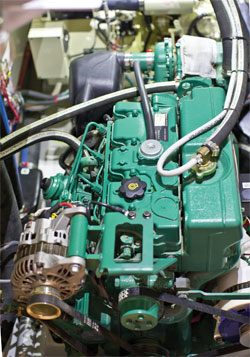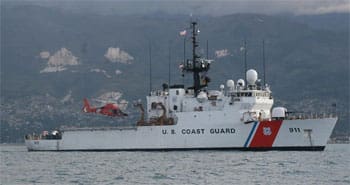Over the course of a three-year assignment as the Chief Engineer of Coast Guard Cutter Forward (WMEC 911), an 1,800-ton, 270-foot long medium endurance cutter, I was responsible for keeping the engineering plant “ready to answer all bells.” This rather broad description included the maintenance and repair of two 3,650-hp propulsion diesel engines, three 450-kW diesel generators, fuel and oil purification and transfer systems, heating ventilation and air conditioning plants and numerous other propulsion, auxiliary, electrical, and damage control systems.
The engineering department, which I am honored to have led, included about 30 officers and enlisted crew who had each received both formal and on-the-job training on the systems to which they were assigned.
There is obviously a big difference between a 270-foot cutter and a voyaging boat. Some of the same principles we use on board Coast Guard cutters, however, apply to the less humble but no less important engine on your boat.
Stand a taut watch
One of the best ways you can ensure your engine is reliable is simply by spending some quality time together. On Navy and Coast Guard ships at sea, the watch manning the bridge is only a small part of the team that is up and about keeping the ship safe 24 hours a day. Among other places there is also a watch team in the engineering control center keeping a close eye on all of the machinery that keeps the vessel running smoothly. On board Forward we had a three-person engineering watch section: an Engineer of the Watch (EOW) who was directly responsible to me and the Officer of the Deck for ensuring proper operation of the entire machinery plant, a Propulsion Watchstander whose primary role was to monitor the propulsion engines and diesel generators, and an Auxiliary Watchstander who made near-constant rounds outside of the main engine room, focused primarily on the multiple compartments containing the ship’s auxiliary systems.
While at sea, I would frequently stand the EOW for the 0800-1200 watch on Sunday mornings to spend some quality time with the plant. Some EOWs liked to stay in the engineering control center, where they could monitor the various readings on the main control console and be ready to respond to an order from the bridge or an unexpected casualty. I preferred to spend the majority of my time on watch walking around with a flashlight, a rag and a spray bottle of cleaner — watching and listening. I found you can learn a tremendous amount just by spending some time really observing the plant. Additionally, I firmly believe that the engineering compartments on a ship should be the cleanest spaces aboard; this way you can more easily find a small problem while it’s still manageable and before it becomes an emergency. After four hours walking through the engine room, I usually had a fairly comprehensive list of items that needed to be addressed — nothing major, but that was the whole point.
Any boat owner could take the same approach of spending some time in your engine compartment with a flashlight, a rag and a spray bottle of cleaner. Inspect all the components of your engine and get comfortable with what each of them do and how they work; look for leaks or drips and make sure everything is spotless — from the engine itself to the fuel filters to the bilge below. If you do this regularly, you’ll find small problems before they become big ones. For the biggest benefit, don’t just do this at the pier with everything quiet and secure; make sure you spend some quality time with the engine running (under load is best). You’d be surprised how quickly you can tell when something doesn’t sound or even smell quite right once you have a good baseline.
Planning and scheduling
Whether we were towing a disabled fishing vessel to safety in 15-foot seas, rescuing Haitian migrants from a grossly overloaded sail freighter, or interdicting multi-ton loads of cocaine in the deep Caribbean, keeping all of the ship’s systems running was vital to ensuring Forward could accomplish her missions. Ensuring that we were prepared for regular maintenance and all but the most complex or unusual repairs was a constant challenge while steaming independently for weeks at a time and hundreds of miles from the nearest technical assistance or parts suppliers. As you can imagine, keeping track of both the work we had done as well as the work we needed to plan for in the future could easily become overwhelming without a way to manage all of this work. Enter the Coast Guard’s system of preventative and corrective maintenance.
Through years of experience and close work with the equipment manufacturers, the Coast Guard has developed detailed preventative maintenance procedures for each class of ship. Some procedures are time-based (e.g., lubricate watertight door hinges every month) while others are hour-based (e.g., change the propulsion diesel engine oil after 500 hours of operation). Each of these hundreds of maintenance items has a card that lists both the parts and supplies required to complete the jobs, as well as a detailed description of the procedure to complete the task. Granted, some of these are simple and the card is more a formality than a requirement, but for other complex or rarely performed tasks, it helps ensure proper procedures are followed and mistakes that could lead to equipment damage or personnel injury are avoided.
The electronic database that organizes all of these tasks helps make scheduling and tracking historical data significantly more manageable. In this computer system, you can look up a piece of equipment (e.g., No. 1 main diesel engine) and find all of the maintenance procedures that are assigned to it, in addition to all of the corrective maintenance (e.g., repairs) that were completed and logged into the database. Alternatively, you can look up an individual maintenance procedure and see when it was last completed and when it will next be required. Perhaps most useful, you can plan for the future and identify all of the preventative maintenance items that will be required in the next month in order to accurately plan your work.
 |
|
John Snyder |
|
Voyagers can help ensure their diesel, like this 75-hp Volvo Penta on the Lyman Morse built Kiwi Spirit, is reliable by spending the time to know it in detail. |
While I certainly don’t recommend that you invest in a complex electronic database to track all of your maintenance and repairs to the extent described above, something as simple as an Excel spreadsheet or log book can go a long way to making sure that you aren’t overlooking some infrequently performed maintenance. You can make different spreadsheets for different pieces of equipment, and add some notes if you noticed something unusual while performing the work. Keep in mind, nothing says that you should only record maintenance on your auxiliary diesel. How about inspecting and lubricating the steering system, winches or anchor windlass?
Of course, the first step is probably determining what maintenance you need to accomplish. I recommend spending some time with your OEM (original equipment manufacturer) manuals. They won’t give you all the answers (and might not be the most exciting reading), but they’re a great start and a fine way to gain a little more knowledge about the systems you have on board. Next, read through some of the plethora of boat maintenance books out there. While these will be more generic and not have details specific to the equipment installed on your particular boat, the principles are the same.
These two approaches, along with spending some time with a mechanically-inclined friend, will put you in a good spot.
Perhaps even more important for the long-distance cruiser or voyager, these recommendations will give you some insight into mechanical issues you’re likely to face. This knowledge will enable you to make sure you have the right tools and parts on board to handle these issues, especially since Murphy always seems to make sure they happen when no one else is around to help and when you absolutely need to have the equipment back up and running.
If you want to take preparation a step further, you could package all the parts for each job together. For example, keep a spare water impeller, together with the gasket, and any required sealing compound together in a zip-close lock bag, with the needed wrench size written on the outside. That way, when the impeller decides to fail while you’re getting tossed around in a cross sea while trying to snake your way through a narrow channel at 0300, you won’t have to dig around all over the boat to find the right parts.
It’s easy to ignore all that hot and hard to reach equipment that the boatbuilder has crammed into a tiny, poorly lit shoe box behind the companionway stairs, but by taking a little extra time and effort and incorporating some of the principles described above, you’ll have no problem making sure your engine and genset are “ready to answer all bells.”
——–
Michael Cilenti is a Coast Guard officer. He served as Chief Engineer of the 270-foot Coast Guard cutter Forward.

